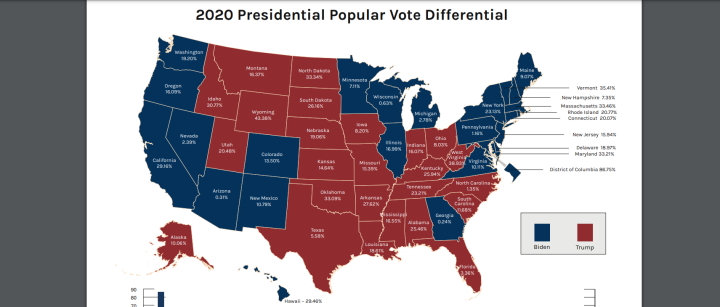Online Post Misrepresents 2020 Wisconsin Voter Data, Turnout

Quick Take
Nearly 3.3 million votes were cast in the 2020 presidential election in Wisconsin, which the state calculated as a record turnout of 73%. A social media post tries to cast doubt on the results by citing incomplete data and claiming it shows “a registered voter turnout of 94%.”
Full Story
The results of the 2020 presidential election continue to be the target of misinformation spread by former President Donald Trump and his supporters, as we’ve previously written.
The swing state of Wisconsin, in particular, has been one focus of Trump’s claims, though election results and a subsequent recount found that President Joe Biden won the state by more than 20,000 votes.
An Instagram post on July 10 revived the false narrative that Trump won Wisconsin, citing the state’s high voter turnout that year. “You’re telling me that 3.3 out of 3.5 million registered Wisconsinites voted in 2020. That’s a registered voter turnout of 94%,” the post says, showing a photo of a child casting an incredulous glance at an adult.
The post correctly reports the number of votes — nearly 3.3 million — cast in the Wisconsin 2020 presidential election. But it gets two things wrong: The number of registered voters and the state’s voter turnout.
The Wisconsin Elections Commission recorded nearly 3.7 million registered voters by Nov. 1, 2020. The Instagram post also fails to account for voters who registered on Election Day in Wisconsin, which is among the 22 states that allows same-day voter registration. In 2020, 6.62% of voters registered on Election Day in Wisconsin, equating to almost 220,000 people. However, this figure also includes voters who change their name, address, or both.
There is also the issue of how to best measure voter turnout.
Barry Burden, a political science professor and director of the Elections Research Center at the University of Wisconsin-Madison, told us in a July 12 email, “Election officials and journalists sometimes compute voter turnout based on registered voters because it is the only concrete denominator that is available for them to use.” However, analysts and researchers prefer using total eligible population. “This is a better reflection of what share of the people who could legally cast ballots did so,” Burden said.
Even then, the exact voter turnout rate can differ depending on how the total eligible population is calculated.
The Wisconsin Elections Commission determines voter turnout as a percentage of the voting-age population, or VAP, as estimated by the Demographic Services Center of the Wisconsin Department of Administration. Using VAP, the Wisconsin Election Commission determined the voter turnout for the 2020 election to be nearly 73%.
“The VAP is a good approximation but is imperfect because it includes non-citizens who are not eligible to vote and excludes eligible Wisconsin residents who are living overseas,” Burden said.
Instead, a better formula comes from the University of Florida US Elections Project, Burden said. The project’s calculation begins with the VAP and then adjusts for non-citizens and ineligible felons, depending on state law. Overseas voters are added only to national estimates and not the state level because there is no reliable way to apportion overseas voters to states. This new figure is called the voting-eligible population, or VEP.
Using the VEP, the US Elections Project calculated Wisconsin’s turnout rate in 2020 to be 75.3%.
It’s a remarkably high voter turnout, Burden said.
“Nationally and in Wisconsin, voter turnout in 2020 hit a modern high-water mark. According to the Wisconsin Elections Commission, only one other election in the state since the 1960s had such a high turnout rate. The overall voter turnout rate in the U.S. appears to be the highest in about a century,” Burden said.
According to the US Elections Project, voter turnout in 2020 was the highest it had been since 1900. However, the project added that “historical turnout rates are calculated from data of dubious accuracy.”
When calculating voter turnout based solely on registered voters, as the Instagram post did, voter turnout in 2020 would have been closer to 85% — although that’s an estimate, because same-day registration includes registered voters who changed their name, address or both on Election Day.
Asked what may have caused an increase in voter participation in 2020, Burden said, “It appears that the jump in voter participation is at least partly a response to Donald Trump’s presence in the White House.”
Editor’s note: FactCheck.org is one of several organizations working with Facebook to debunk misinformation shared on social media. Our previous stories can be found here. Facebook has no control over our editorial content.
Sources
Robertson, Lori et al. “Trump Repeats Baseless, False Claims About the Election.” FactCheck.org. 30 Nov 2020.
Farley, Robert. “More Trump Election Distortions.” FactCheck.org. 16 Jul 2021.
Farley, Robert. “Evidence Gaps in ‘2000 Mules.’” FactCheck.org. 13 Jun 2022.
Kiely, Eugene. “Trump’s Bogus Swing State Claim.” FactCheck.org. 9 Dec 2020.
Wisconsin Election Commission. “WEC Canvass Reporting System.” Accessed 12 Jul 2023.
National Conference of State Legislatures. “Same-Day Voter Registration.” Accessed 12 Jul 2023.
Wisconsin Election Commission. “November 1, 2020 Voter Registration Statistics.” Accessed 12 Jul 2023.
Wisconsin Election Commission. “Voter Turnout.” Accessed 12 Jul 2023.
Burden, Barry. Political science professor, University of Wisconsin-Madison. Email to FactCheck.org. 12 Jul 2023.
McDonald, Michael P. “Overview of how the voting-eligible population (VEP) is constructed.” United States Elections Project. Accessed 12 Jul 2023.
McDonald, Michael P. “2020g.” United States Elections Project. Accessed 12 Jul 2023.
McDonald, Michael P. “National Turnout Rates 1789-Present.” United States Elections Project. Accessed 12 Jul 2023.
This article has been archived for your research. The original version from FactCheck.org can be found here.


